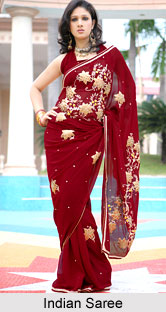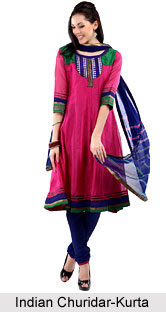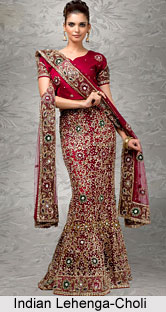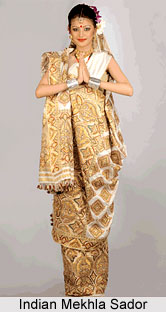Type of clothing in India is mainly dependent on the various regions, cultures, geography, climate and the local traditions of the numerous states, districts, towns and villages of this country. The Indian populace prefers various kinds of clothing, ranging from simple `dhotis`, `lungis`, kurta- pyjamas, sarees to contemporary fashionable accessories like sherwanis, jeans, different types of skirts, tops, Western formals like shirts and trousers amongst manifold other items. Indian dresses also vary according to festive, social or religious festivals and regional traditional customs of the nation. Communities belonging to Hindus, Muslims, Christians, Anglo- Indians, Sikhs and Parsis are clad in their specific Indian costumes.
 Saree
Saree
Sarees form the traditional attire for Indian women and are unstitched Indian clothes which are wrapped around the body in several different forms, as per the norms of the various Indian states. Sarees possess many kinds of names, depending on the region of their origin. For example, Banarasi sarees of Northern India, Sambalpuri sarees of Eastern India, Paithani sarees of Western India, Kanjeevaram sarees of Southern India, Pashmina silk sarees of Kashmir, Baluchari sarees of the state of West Bengal, etc are a few categories of the multiple kinds of sarees found in India. Blouses are worn alongwith sarees, and halter necks, backless and designer blouses are quite popular among modern Indian women. Pudavai of Tamil Nadu, kupsas of Karnataka, Bandhani sarees, Chanderi, Gujarati brocade sarees and many other varieties of sarees exist in India. Maharashtrian style, Bengali style, Gujarati style and Bengali style are the existent styles of draping the saree.
Salwar Kameez
Salwar kameez is the customary attire of Punjabi women and are also used by the ladies residing in the North-Indian states of Haryana, Himachal Pradesh and Kashmir. Women in Sindh and Kashmir generally wear the `suthan`, which is similar to the salwar kameez. Loose trousers which are tied around the waist and long tunics are the main characteristics of this costume. A `dupatta` or `odhani` (veil) is used to accompany a salwar kameez. The fabric of dupatta includes georgette, chiffon, silk, cotton and others. Several Bollywood movies have popularized the concept of wearing salwar kameez.
 Churidar-Kurta
Churidar-Kurta
Churidar-kurta is a contemporary version of the salwar kameez. Churidar is a beautiful pyjama which gathers near the ankles and is fitted tightly below the knees. A long kurta is clad, to accompany the churidar and this tunic extends below the knees. The design of churidar marks a sharp contrast with that of salwar kameez. The churidar kurta cannot be combined with a dupatta or chunni, unlike salwar kameez. Kurtas are generally made of various designs, styles and are adorned with gorgeous motifs. It is shaped like a long shirt and is said to be the Indian counterpart of skinny jeans, which form a garment of Western countries.
 Lehenga Choli
Lehenga Choli
Lehenga choli, also referred to as the ghagra choli is the traditional Indian costume of the states of Gujarat and Rajasthan. The attire includes the lehenga, a tight-fitting choli and odhani or stylish dupatta. The choli is mainly a smart garment with short sleeves, low neck and elaborate designs of rich embroidery. Numerous styles of lehengas are popular amongst Indian ladies, particularly the ones which are embellished with mirrors and used during the Garba dance in Navaratri. Ghagra cholis are very sought after attires, especially during festivals and Indian weddings. Lehengas are also worn by Indian brides during their marriage. Chaniya choli is yet another variety of this very same Indian costume. However, they are generally avoided as a regular wear due to their heavy and elaborate clothing materials. Contemporary Indian designers are fond of experimenting with the styles and patterns of this type of Indian dress.
Pattu Pavadai
Pattu Pavadai, also termed as `langa davani` is a traditional Indian costume popular in Southern parts of the country and is mainly worn by teenagers and little girls. Pavada is a conical, silk garment, decorated with a golden border. It consists of a long piece of cloth which hangs from the waist, straight to the toes. Rajasthani girls also wear this garment prior to their wedding.
Mundum Neriyathum
Residents of Southern India, especially Kerala are known to use this cloth. The lower piece of garment is known as the `mundu` while the upper part of the cloth is termed as the `neriyathu`. This attire is the ancient form of saree worn by the local women of Kerala.
 Mekhela-Sador
Mekhela-Sador
Mekhela-Sador is a unique, traditional Assamese costume generally worn by Assamese women, belonging to all ages. It comprises three pieces of garments. It is clad like a sarong, which is attached to the waist and tucked inside. The pleats of Mekhela are towards the right side, as against the folds in the Nivi style of the Indian saree which are pleated to the left side. An underskirt is used while wearing it. Strings are never utilized to tie a Mekhela. The Sador is a long cloth which is wrapped over the upper portion of the body. `Riha` is the third piece which is worn under Sador and is narrow. The Riha is worn like an Orni.
Dhoti
Dhoti is one of the ancient traditional costumes of India and is generally used in various portions of the nation, especially Southern India. Men in Indian villages are often clad in dhoti. Measuring about four to six feet in length, a dhoti is a white strip of garment. It is carefully wrapped around both the legs and tucked near the waist with the aide of a belt which might be decorative, jewelled or embroidered. A dhoti is named the `Mundu` in Hindi, Marathi, `Pancha` in Telugu, `veshti` in the state of Tamil Nadu and `panche or lungi` in Kannada. Shirts are worn alongwith dhotis.
Sherwani
Indian menswear includes a long, beautiful jacket with buttons throughout the entire length of the attire of sherwani. Nehru collars are attractive features of sherwanis. The length of Indian costumes reaches upto the knees and is worn alongwith tight trousers which are called churidars. The churidars are loosely fitted around the thighs but are right near the ankles. Sherwanis are often used during weddings and other festive occasions. Indian grooms favour sherwanis, which are brightly coloured or cream coloured and decorated with semi precious stones. Sometimes a scarf or dupatta is used to compliment a sherwani.
Headgear
Headgears like the Indian turban or `pagri` is popular in several parts of India. Other kinds of headgear like `Gandhi cap` and `Taqiyah` are also worn in the country. `Dastar` pagri is worn by the Sikhs, `Pheta` is used by the Marathis in Maharashtra, `Mysore Pheta` pagri which were worn by the kings of Mysore and `Rajasthani pagari` which is worn by the local residents of Rajasthan.
Indian garments are available in vibrant colours, patterns, styles and designs which depict the versatility and unique beauty of Indian women. Therefore, besides the several kinds of Indian menswear, Indian markets are flooded with diverse forms of fashionable accessories for Indian women. Inhabitants of urban India have adopted a Westernized style of dressing, while residents of rural areas of the country have adhered to the traditional costumes like dhoti-kurta, or saree. Indians favour a wide variety of clothing due to the fact that every state of India is represented in different ways, through their indigenous garments.





















